Index to Trees & Shrubs in the Order Rosales
Family: Moraceae (Fig or Mulberry Family)
063. Ficus abutilifolia Large-leaved Rock Fig, Rock Wild Fig https://africawild-forum.com/viewtopic. ... 94#p175194
055. Ficus ingens Red-leaved Rock Fig https://africawild-forum.com/viewtopic. ... 50#p512950
047. Ficus sansibarica Knobbly Fig, Large-fruited Fig https://africawild-forum.com/viewtopic. ... 52#p503352
066. Ficus sycomorus Sycamore Fig Tree, Fig-mulberry Tree https://africawild-forum.com/viewtopic. ... 97#p171497
Family: Rhamnaceae (Dogwood Family)
449. Berchemia discolor Brown Ivory https://africawild-forum.com/viewtopic. ... 98#p171500
447. Ziziphus mucronata mucronata Buffalo Thorn https://africawild-forum.com/viewtopic. ... 19#p230619
Africa Wild Tree & Shrub Book - Order Rosales
Moderator: Klipspringer
Re: Africa Wild Tree & Shrub Book - Order Rosales
66. Sycamore Fig Tree, Fig-mulberry Tree Ficus sycomorus
Order: Rosales. Family: Moraceae
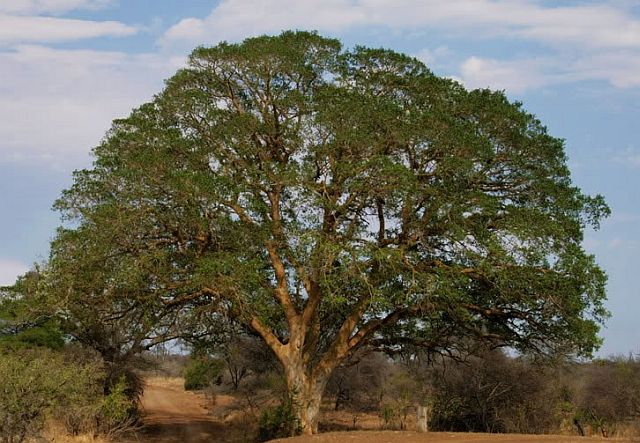 © leachy
© leachy
Kruger National Park
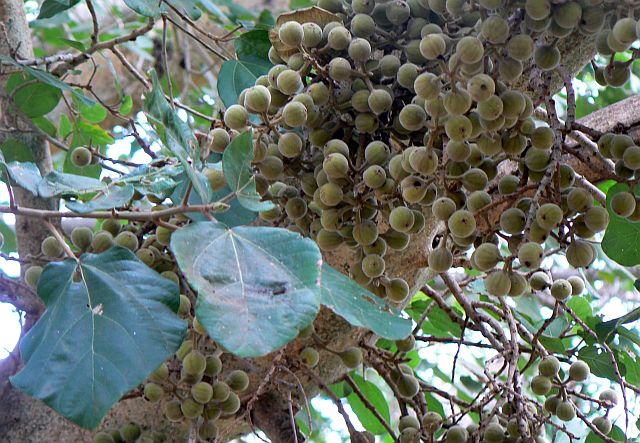 © Toko
© Toko
Kruger National Park, Letaba
Description
Ficus sycomorus grows to 20 m tall and 6 m wide with a dense round crown of spreading branchesand a short thick trunk. All parts exude a milky latex. Bark very characteristically yellowish, smooth, flaking in irregular patches.
The leaves are alternatae, almoust round to ovate, heart-shaped with a round apex, 14 cm long by 10 cm wide, and arranged spirally around the twig. They are dark green above and lighter with prominent yellow veins below, and both surfaces are rough to the touch. Venation prominent below, somewhat 3-veined from the base with 4-8 pairs of lateral veins.
The fruit is a large edible fig, ripening from buff-green to yellow or red. Figs borne in large branched clusters from the main stem and larger branches, subspherical, up to 3 cm in diameter, usually densely, finely hairy.
Flowering and fruiting occurs year-round, peaking from July to December. The bark is green-yellow to orange and exfoliates in papery strips to reveal the yellow inner bark. Like all other figs, it contains a latex.
Distribution
Ficus sycomorus is native to Africa south of the Sahel and north of the Tropic of Capricorn, also excluding the central-west rainforest areas. Provincial distribution in South Africa: KwaZulu-Natal, Limpopo, Mpumalanga.
Habitat
Large free standing tree in riverine valleys.
Links: FigWeb; Documentary BBC Natural World 2005 Queen of Trees wildlife animals: Sycamore Fig
Order: Rosales. Family: Moraceae
 © leachy
© leachyKruger National Park
 © Toko
© TokoKruger National Park, Letaba
Description
Ficus sycomorus grows to 20 m tall and 6 m wide with a dense round crown of spreading branchesand a short thick trunk. All parts exude a milky latex. Bark very characteristically yellowish, smooth, flaking in irregular patches.
The leaves are alternatae, almoust round to ovate, heart-shaped with a round apex, 14 cm long by 10 cm wide, and arranged spirally around the twig. They are dark green above and lighter with prominent yellow veins below, and both surfaces are rough to the touch. Venation prominent below, somewhat 3-veined from the base with 4-8 pairs of lateral veins.
The fruit is a large edible fig, ripening from buff-green to yellow or red. Figs borne in large branched clusters from the main stem and larger branches, subspherical, up to 3 cm in diameter, usually densely, finely hairy.
Flowering and fruiting occurs year-round, peaking from July to December. The bark is green-yellow to orange and exfoliates in papery strips to reveal the yellow inner bark. Like all other figs, it contains a latex.
Distribution
Ficus sycomorus is native to Africa south of the Sahel and north of the Tropic of Capricorn, also excluding the central-west rainforest areas. Provincial distribution in South Africa: KwaZulu-Natal, Limpopo, Mpumalanga.
Habitat
Large free standing tree in riverine valleys.
Links: FigWeb; Documentary BBC Natural World 2005 Queen of Trees wildlife animals: Sycamore Fig
Re: Africa Wild Tree & Shrub Book - Order Rosales
449. Brown Ivory Berchemia discolor (Bruin-ivoor)
Order: Rosales. Family: Rhamnaceae
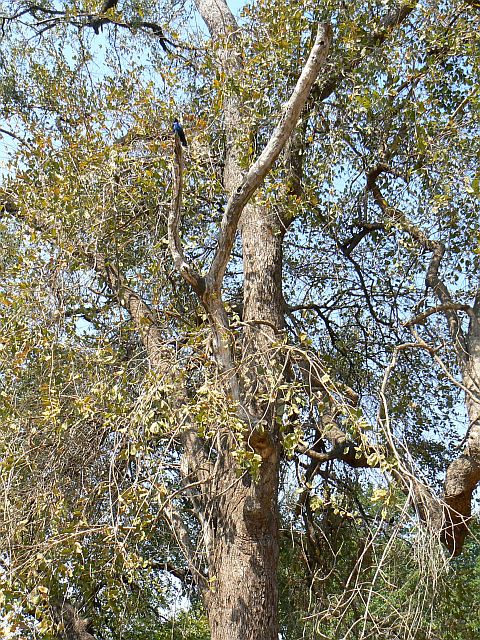
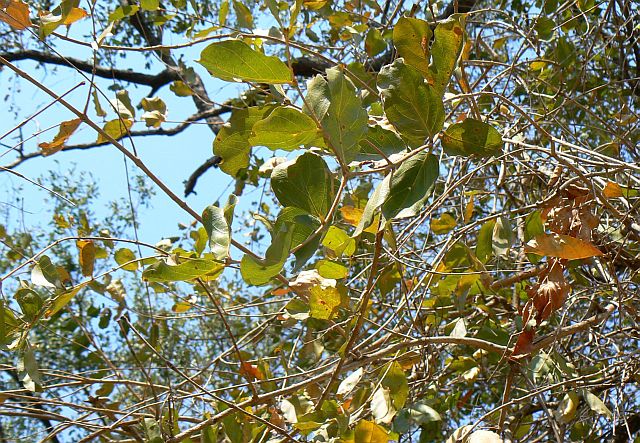
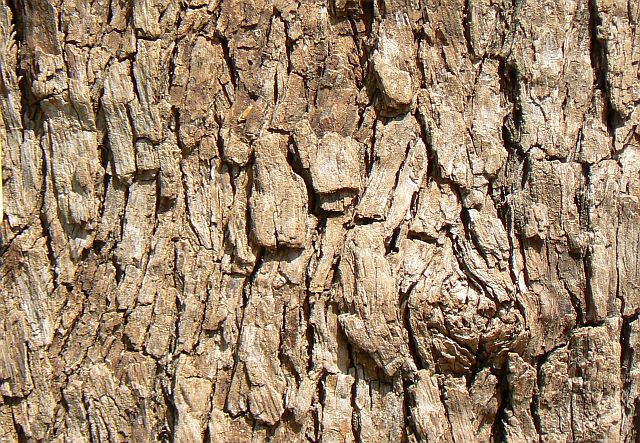
Description
A semi-deciduous to evergreen shrub or a tree 3-20 m high; with a straight bole; rough, dark grey bark that flakes longitudinally; dense, rounded crown; slash yellow; young branches conspicuously lenticellate; branchlets glabrous to densely pubescent with short, spreading, whitish hairs. Leaves alternate or sub-opposite, entirely or obscurely crenate, shiny above, dull and glaucous below, broadly elliptic, ovate or obovate-elliptic-lanceolate, 2-9 x 2-5 cm, obtuse or acute at the apex, rounded or cuneate at the base; leaf stalks glabrous or pubescent, 1-1.8 cm long. It bears small clusters of yellowish-green flowers. Flowers small, solitary, thick, oblong or ellipsoid, 4-5 mm in diameter, greenish when young, turning yellowish after ripening. The datelike fruit is a fleshy blue-green berry which ripens to yellow, up to 20 x 8 mm with 1-2 flat seeds in sweet, edible flesh.The bark is smooth and grey-green on young twigs and darkens with age.
Distribution
Angola, Botswana, Eritrea, Ethiopia, Kenya, Madagascar, Malawi, Mozambique, Namibia, Somalia, South Africa (Provincial distribution: Limpopo, Mpumalanga), Swaziland, Tanzania, Uganda, Yemen, Republic of, Zambia, Zimbabwe.
Habitat
It is found scattered in semi-desert grassland, open woodland or along river valleys, especially on termite mounds. It is common in riverine forests, woodland and wooded grassland.
Links: Ernst Schmidt, Mervyn Lotter, Warren McCleland: Trees and Shrubs of Mpumalanga and Kruger National Park
Order: Rosales. Family: Rhamnaceae



Description
A semi-deciduous to evergreen shrub or a tree 3-20 m high; with a straight bole; rough, dark grey bark that flakes longitudinally; dense, rounded crown; slash yellow; young branches conspicuously lenticellate; branchlets glabrous to densely pubescent with short, spreading, whitish hairs. Leaves alternate or sub-opposite, entirely or obscurely crenate, shiny above, dull and glaucous below, broadly elliptic, ovate or obovate-elliptic-lanceolate, 2-9 x 2-5 cm, obtuse or acute at the apex, rounded or cuneate at the base; leaf stalks glabrous or pubescent, 1-1.8 cm long. It bears small clusters of yellowish-green flowers. Flowers small, solitary, thick, oblong or ellipsoid, 4-5 mm in diameter, greenish when young, turning yellowish after ripening. The datelike fruit is a fleshy blue-green berry which ripens to yellow, up to 20 x 8 mm with 1-2 flat seeds in sweet, edible flesh.The bark is smooth and grey-green on young twigs and darkens with age.
Distribution
Angola, Botswana, Eritrea, Ethiopia, Kenya, Madagascar, Malawi, Mozambique, Namibia, Somalia, South Africa (Provincial distribution: Limpopo, Mpumalanga), Swaziland, Tanzania, Uganda, Yemen, Republic of, Zambia, Zimbabwe.
Habitat
It is found scattered in semi-desert grassland, open woodland or along river valleys, especially on termite mounds. It is common in riverine forests, woodland and wooded grassland.
Links: Ernst Schmidt, Mervyn Lotter, Warren McCleland: Trees and Shrubs of Mpumalanga and Kruger National Park
Re: Africa Wild Tree & Shrub Book - Order Rosales
63. Large-leaved Rock Fig, Rock Wild Fig Ficus abutilifolia (Grootblaar-rotsvy, Klip-vy)
Order: Rosales. Family: Moraceae
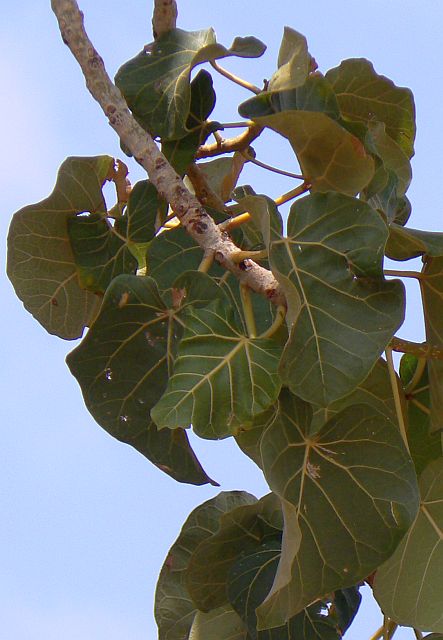 © Toko
© Toko
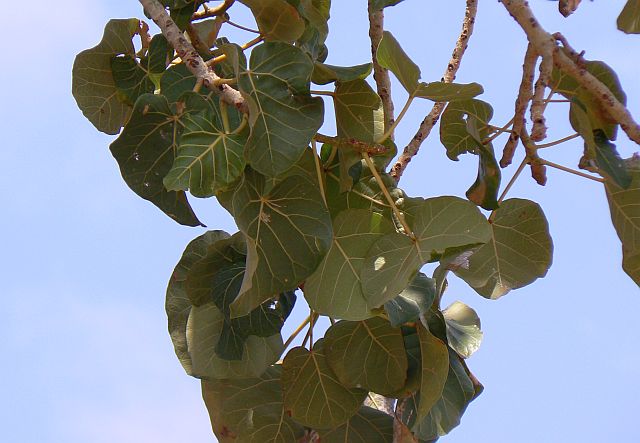 © Toko
© Toko
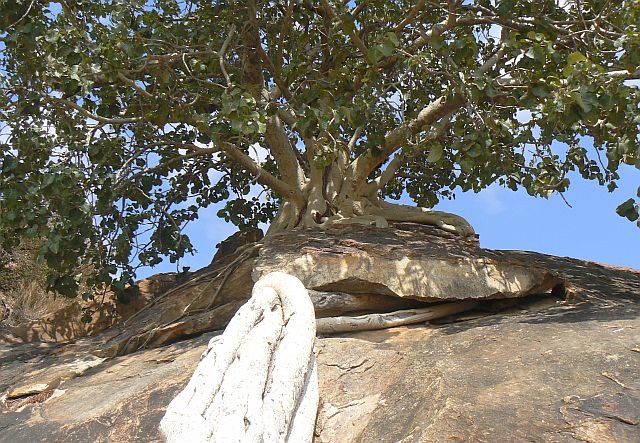 © Toko
© Toko
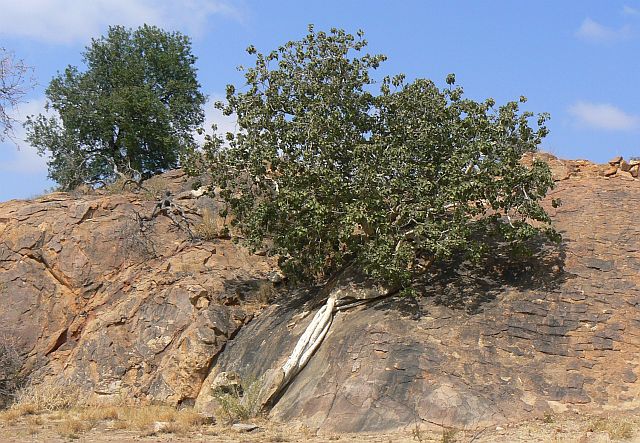 © Toko
© Toko
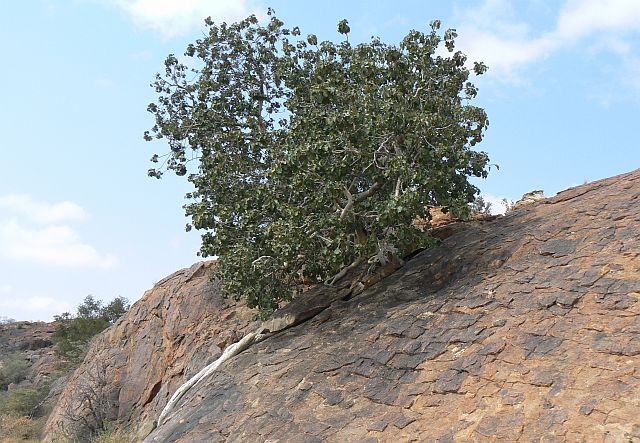 © Toko
© Toko
Mapungubwe National Park, Limpopo
Description
Shrub or small tree, deciduous to semi-deciduous tree up to 15 m high, though it seldom exceeds 5 m. Bark smooth and creamy-white or yellowish, the trunk twisted and branching low; leaves alternate, hairless, leathery, almost circular, veins yellow-green conspicuous. The leaves are broadly ovate and heart-shaped to almost round and are cordate at the base, ranging in size from 75-200 x 65-180 mm. They are glabrous on both surfaces, occasionally with velvety hairs beneath, with 4-9 pairs of secondary veins, entire wavy margins and a petiole up to 120 mm long.
The fruit, which are 15-25 mm in diameter, are borne singly or in pairs in the leaf axils on terminal branchlets, and are smooth to slightly hairy. They may be sessile or on short, stout stalks up to 15 mm long and are green becoming yellow or red when ripe. Read more about what is unusual about fig fruits and their pollination on the Ficus trichopoda page.
Similar species: Ficus abutilifolia is a fairly distinct species but does resemble Ficus tettensis and Ficus glumosa which are readily distinguished by their smaller, hairy leaves and hairy branchlets.
Distribution
There are wo disjunct populations: a northern one extending from Somali to Guinea and a southern one: NE South Africa (Gauteng, KwaZulu-Natal, Limpopo, Mpumalanga, North West), Zimbabwe, E Botswana, W Mozambique, Malawi, E Zambia, SE Democratic Republic of Congo & SW Tanzania.
Habitat
Savanna woodland or bushveld, usually on rocks (granite, basalt, sandstone, ironstone) up to an altitude of 1000 m. It typically scrambles over rocks, growing from cracks and crevices, eventually splitting the rock ours hotter, low lying areas, not able to tolerate heavy frost.
Links: PlantZAfrica; FigWeb; Ernst Schmidt, Mervyn Lotter, Warren McCleland: Trees and Shrubs of Mpumalanga and Kruger National Park
Order: Rosales. Family: Moraceae
 © Toko
© Toko © Toko
© Toko © Toko
© Toko © Toko
© Toko © Toko
© TokoMapungubwe National Park, Limpopo
Description
Shrub or small tree, deciduous to semi-deciduous tree up to 15 m high, though it seldom exceeds 5 m. Bark smooth and creamy-white or yellowish, the trunk twisted and branching low; leaves alternate, hairless, leathery, almost circular, veins yellow-green conspicuous. The leaves are broadly ovate and heart-shaped to almost round and are cordate at the base, ranging in size from 75-200 x 65-180 mm. They are glabrous on both surfaces, occasionally with velvety hairs beneath, with 4-9 pairs of secondary veins, entire wavy margins and a petiole up to 120 mm long.
The fruit, which are 15-25 mm in diameter, are borne singly or in pairs in the leaf axils on terminal branchlets, and are smooth to slightly hairy. They may be sessile or on short, stout stalks up to 15 mm long and are green becoming yellow or red when ripe. Read more about what is unusual about fig fruits and their pollination on the Ficus trichopoda page.
Similar species: Ficus abutilifolia is a fairly distinct species but does resemble Ficus tettensis and Ficus glumosa which are readily distinguished by their smaller, hairy leaves and hairy branchlets.
Distribution
There are wo disjunct populations: a northern one extending from Somali to Guinea and a southern one: NE South Africa (Gauteng, KwaZulu-Natal, Limpopo, Mpumalanga, North West), Zimbabwe, E Botswana, W Mozambique, Malawi, E Zambia, SE Democratic Republic of Congo & SW Tanzania.
Habitat
Savanna woodland or bushveld, usually on rocks (granite, basalt, sandstone, ironstone) up to an altitude of 1000 m. It typically scrambles over rocks, growing from cracks and crevices, eventually splitting the rock ours hotter, low lying areas, not able to tolerate heavy frost.
Links: PlantZAfrica; FigWeb; Ernst Schmidt, Mervyn Lotter, Warren McCleland: Trees and Shrubs of Mpumalanga and Kruger National Park
Re: Africa Wild Tree & Shrub Book - Order Rosales
447. Buffalo Thorn Ziziphus mucronata mucronata (Blinkblaar-wag-'n-bietjie)
Order: Rosales. Family: Rhamnaceae
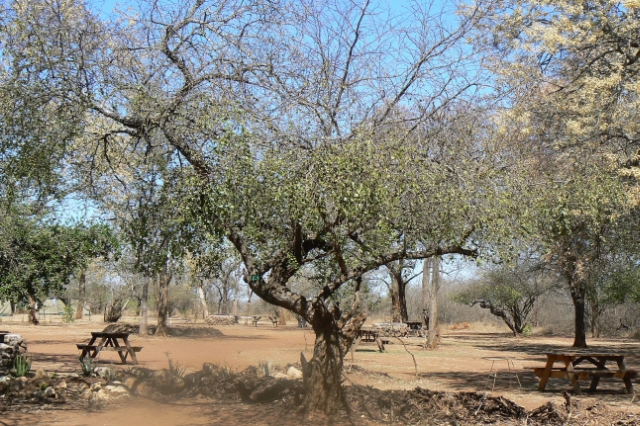
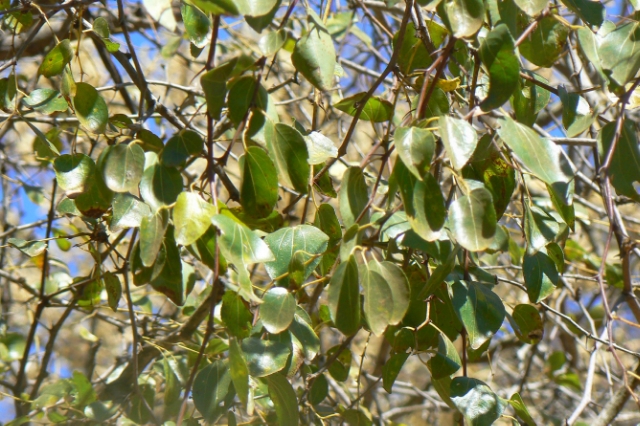
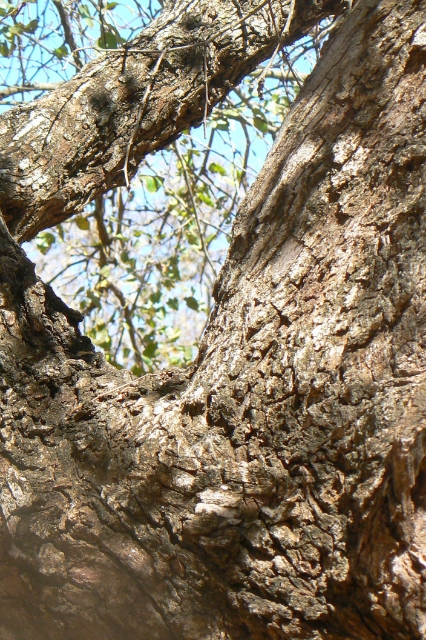
Swaziland, Hlane Royal National Park, Ndlovu Camp
Description
A small to medium-sized tree, 3-12 m tall; with a spreading canopy and a single trunk, usually armed with a hooked and a straight spine at each node at the vase of the leaves. The main stem is green and hairy when young; year old branches often zigzag; the bark is reddish brown or roughly mottled grey, cracked into small rectangular blocks, revealing a red and stringy under-surface. Young stems are reddish brown.
Leaves are simple, alternate; ovate or broadly ovate; vary enormously in size from tree to tree, 30-90 x 20-50 mm, tapering or often mucronate apex, base strongly asymmetrical, cordate to rounded on one side; margin finely serrated, often badly eaten by insects, glossy green above, slightly hairy and paler below; 3- to 5-veined from the base; veins covered with fine hairs when young; petiole up to 20 mm long; stipules, when present, take the form of small thorns at the nodes, one straight and one hooked. Leaves turn golden yellow in autumn. Flowers are borne in dense clusters in leaf axils; green to yellowish; ± 4 mm in diameter; inconspicuous (October-February). The fruit is a smooth, shiny, leathery, spherical drupe, 12-20 mm in diameter, reddish-brown or deep red when ripe, slightly sweet, the pulp is dry. The berries sometimes stays on the plant long after the leaves have fallen (March to August). The seeds are usually solitary, elliptic and compressed.
Distribution
Throughout the summer rainfall areas of sub-Saharan Africa, extending from South Africa (Eastern Cape, Free State, Gauteng, KwaZulu-Natal, Limpopo, Mpumalanga, Northern Cape, North West) northwards to Ethiopia and Arabia.
Habitat
Bushveld, woodlands, open scrubland, on rocky koppies, open grasslands, on a variety of soils along streams, nutrient-rich valley bottoms and forest margins.
Links: Trees and Shrubs of Mpumalanga and Kruger National Park; Sappi Tree Spotting: Kwazulu-Natal and Eastern Cape
Order: Rosales. Family: Rhamnaceae



Swaziland, Hlane Royal National Park, Ndlovu Camp
Description
A small to medium-sized tree, 3-12 m tall; with a spreading canopy and a single trunk, usually armed with a hooked and a straight spine at each node at the vase of the leaves. The main stem is green and hairy when young; year old branches often zigzag; the bark is reddish brown or roughly mottled grey, cracked into small rectangular blocks, revealing a red and stringy under-surface. Young stems are reddish brown.
Leaves are simple, alternate; ovate or broadly ovate; vary enormously in size from tree to tree, 30-90 x 20-50 mm, tapering or often mucronate apex, base strongly asymmetrical, cordate to rounded on one side; margin finely serrated, often badly eaten by insects, glossy green above, slightly hairy and paler below; 3- to 5-veined from the base; veins covered with fine hairs when young; petiole up to 20 mm long; stipules, when present, take the form of small thorns at the nodes, one straight and one hooked. Leaves turn golden yellow in autumn. Flowers are borne in dense clusters in leaf axils; green to yellowish; ± 4 mm in diameter; inconspicuous (October-February). The fruit is a smooth, shiny, leathery, spherical drupe, 12-20 mm in diameter, reddish-brown or deep red when ripe, slightly sweet, the pulp is dry. The berries sometimes stays on the plant long after the leaves have fallen (March to August). The seeds are usually solitary, elliptic and compressed.
Distribution
Throughout the summer rainfall areas of sub-Saharan Africa, extending from South Africa (Eastern Cape, Free State, Gauteng, KwaZulu-Natal, Limpopo, Mpumalanga, Northern Cape, North West) northwards to Ethiopia and Arabia.
Habitat
Bushveld, woodlands, open scrubland, on rocky koppies, open grasslands, on a variety of soils along streams, nutrient-rich valley bottoms and forest margins.
Links: Trees and Shrubs of Mpumalanga and Kruger National Park; Sappi Tree Spotting: Kwazulu-Natal and Eastern Cape
-
Klipspringer
- Global Moderator
- Posts: 5862
- Joined: Sat Sep 14, 2013 12:34 pm
- Country: Germany
- Contact:
Re: Africa Wild Tree & Shrub Book - Order Rosales
47. Knobbly Fig, Large-fruited Fig Ficus sansibarica
Order: Rosales. Family: Moraceae
Kruger National Park, Olifants camp © harrys
Description
Ficus sansibarica is a large tree with a spreading crown, up to 20 x 30 m. It may grow as an ordinary, stand-alone tree or a strangler; if it does that, it usually starts life as an epiphyte in the branches of a host plant, sending down aerial roots that encircle the tree and finally kill it so that it stands alone. The knobbly fig is generally evergreen but may be partially deciduous during drought. It is usually without aerial roots, and contains milky latex.
The bark is grey to dark grey, smooth, uneven and does not peel off. The main stem is usually short, forming branches low down and bearing numerous unbranched fruiting spurs. The branches are slightly flaking and hairless.
Leaves: petiole 2-5.5 cm; lamina usually oblong to lanceolate, often less than 10 cm, glabrous; margin entire.
The fruits are 40 mm, hairless, and dark purple with yellow-green dots when ripe, and are borne singly or up to four in a cluster. The fruits are edible but unpleasant. Figs 2-4 together on short branched, cushion-shaped spurs or on straight or curved spurs, borne on the old wood. Fig-bearing spurs up to 3.5 (-5) cm. long. Figs 2-6 cm in diameter when fresh
Distribution
The knobbly fig is found in South Africa in Mpumalanga, Lowveld and Limpopo; in Eswatini, Mozambique, Zimbabwe, Zambia, Malawi, Tanzania and Kenya.
Habitat
Forest, coastal bushland and along watercourses in savanna, up to an altitude of 900m. It is generally limited to diverse, semi-deciduous, coastal scrub forest and low-altitude riverine forest, also occurring in bushveld, on deep sandy soil and in lowveld areas along the base of the escarpment, mainly on rocky hills.
Ecology
The knobbly fig produces a lot of figs which attracts a wide range of fruit-eating birds, fruit bats, baboons, monkeys, insects as well as insectivorous birds which feed upon the wasps that pollinate the figs. New fruit appears from September and they ripen from December to March, although some trees have fruits on them as late as May or June. The leaves are also browsed by elephants, giraffe, kudu and nyala. The fruit has a thick, bright pink or maroon flesh when fully ripe and tastes bitter, but is a favourite of squirrels and local people. All the birds, insects and bats attracted to the fruit, create a magnificent mini-ecosystem.
Pollinator: Courtella armata.
Kruger National Park, Olifants camp.
The Knobbly Fig is usually confined to sporadic localities along the base of the escarpment in Mpumalanga, the trees in Olifants camp were planted the late 1970s. But it grows naturally only in the higher rainfall areas and areas with deep sand in the far NE of the Kruger National Park, not accessible to the general public.
Links: FigWeb
http://pza.sanbi.org/ficus-sansibarica
https://books.google.de/books?id=RpVJJH ... rk&f=false
Order: Rosales. Family: Moraceae
Kruger National Park, Olifants camp © harrys
Description
Ficus sansibarica is a large tree with a spreading crown, up to 20 x 30 m. It may grow as an ordinary, stand-alone tree or a strangler; if it does that, it usually starts life as an epiphyte in the branches of a host plant, sending down aerial roots that encircle the tree and finally kill it so that it stands alone. The knobbly fig is generally evergreen but may be partially deciduous during drought. It is usually without aerial roots, and contains milky latex.
The bark is grey to dark grey, smooth, uneven and does not peel off. The main stem is usually short, forming branches low down and bearing numerous unbranched fruiting spurs. The branches are slightly flaking and hairless.
Leaves: petiole 2-5.5 cm; lamina usually oblong to lanceolate, often less than 10 cm, glabrous; margin entire.
The fruits are 40 mm, hairless, and dark purple with yellow-green dots when ripe, and are borne singly or up to four in a cluster. The fruits are edible but unpleasant. Figs 2-4 together on short branched, cushion-shaped spurs or on straight or curved spurs, borne on the old wood. Fig-bearing spurs up to 3.5 (-5) cm. long. Figs 2-6 cm in diameter when fresh
Distribution
The knobbly fig is found in South Africa in Mpumalanga, Lowveld and Limpopo; in Eswatini, Mozambique, Zimbabwe, Zambia, Malawi, Tanzania and Kenya.
Habitat
Forest, coastal bushland and along watercourses in savanna, up to an altitude of 900m. It is generally limited to diverse, semi-deciduous, coastal scrub forest and low-altitude riverine forest, also occurring in bushveld, on deep sandy soil and in lowveld areas along the base of the escarpment, mainly on rocky hills.
Ecology
The knobbly fig produces a lot of figs which attracts a wide range of fruit-eating birds, fruit bats, baboons, monkeys, insects as well as insectivorous birds which feed upon the wasps that pollinate the figs. New fruit appears from September and they ripen from December to March, although some trees have fruits on them as late as May or June. The leaves are also browsed by elephants, giraffe, kudu and nyala. The fruit has a thick, bright pink or maroon flesh when fully ripe and tastes bitter, but is a favourite of squirrels and local people. All the birds, insects and bats attracted to the fruit, create a magnificent mini-ecosystem.
Pollinator: Courtella armata.
Kruger National Park, Olifants camp.
The Knobbly Fig is usually confined to sporadic localities along the base of the escarpment in Mpumalanga, the trees in Olifants camp were planted the late 1970s. But it grows naturally only in the higher rainfall areas and areas with deep sand in the far NE of the Kruger National Park, not accessible to the general public.
Links: FigWeb
http://pza.sanbi.org/ficus-sansibarica
https://books.google.de/books?id=RpVJJH ... rk&f=false
-
Klipspringer
- Global Moderator
- Posts: 5862
- Joined: Sat Sep 14, 2013 12:34 pm
- Country: Germany
- Contact:
Re: Africa Wild Tree & Shrub Book - Order Rosales
55. Red-leaved Rock Fig Ficus ingens
Order: Rosales. Family: Moraceae
Kruger National Park, Shingwedzi © harrys
Description
Ficus ingens is is an evergreen tree with a briefly deciduous period, is up to 10 m, occasionally higher, with a rounded or spreading crown and with a spread of up to 30 m wide. All the parts have milky latex when broken. The bark is grey, smooth and becomes cracked in older specimens.
The heart-shaped or lanceolate, dull green leaves are hairless and leathery, with conspicuous yellow veins running parallel from the midrib and loping along the margin with three distinct veins at the base, up to 165 mm long and 85 mm wide. New leaves are coppery or reddish.
Stalked fruit or small figs are borne in pairs or singly in the leaf axil or on bare stems below the leaves. Figs are white at first, becoming pink, red or purple when mature and are soft and fleshy. Fruits are found on the tree usually throughout the year but peaking in summer.
Distribution
SA Distribution: Eastern Cape, Gauteng, KwaZulu-Natal, Limpopo, Mpumalanga, North West.
Habitat
Ficus ingens grows in various habitats but usually outside forest and prefers rocky outcrops and cliff faces throughout the bushveld, wooded grassland and coastal regions. It occurs in the moist eastern subtropical or temperate regions of South Africa. The roots spread across rock faces and penetrate almost imperceptible cracks, sometimes splitting the rock.
Ecology
All fig trees depend entirely on fig wasps for pollination, and in turn, the fig wasps can breed nowhere else but inside figs. Hundreds of tiny flowers of Ficus line the inside of the fig or central cavity where they can only be reached by the wasps crawling through the ostiole or opening. Once inside, the wasps pollinate the flowers. This relationship between the Ficus species and wasps is highly host-specific, each tree species pollinated by only one wasp species and neither party can survive without the other. Once the wasps have pollinated the fig, it ripens, changing colour and smell, which attracts fruit-eating birds, bats, monkeys and even lizards. The pollinator of F. ingens is the wasp Platyscapa soraria.
This tree is important ecologically for its food, shade and shelter. Many Birds – including bulbuls seek the Fruit. Monkeys and baboons also feed on the fruit.
Common names: red-leaved rock fig (Eng.); rooiblaarvy (Afr.); mohlatsa (North Sotho); motlhatsa (Tswana); tshikululu (Venda); umthombe (Xhosa); umgonswane (Zulu)
Links:
https://treesa.org/ficus-ingens/
Order: Rosales. Family: Moraceae
Kruger National Park, Shingwedzi © harrys
Description
Ficus ingens is is an evergreen tree with a briefly deciduous period, is up to 10 m, occasionally higher, with a rounded or spreading crown and with a spread of up to 30 m wide. All the parts have milky latex when broken. The bark is grey, smooth and becomes cracked in older specimens.
The heart-shaped or lanceolate, dull green leaves are hairless and leathery, with conspicuous yellow veins running parallel from the midrib and loping along the margin with three distinct veins at the base, up to 165 mm long and 85 mm wide. New leaves are coppery or reddish.
Stalked fruit or small figs are borne in pairs or singly in the leaf axil or on bare stems below the leaves. Figs are white at first, becoming pink, red or purple when mature and are soft and fleshy. Fruits are found on the tree usually throughout the year but peaking in summer.
Distribution
SA Distribution: Eastern Cape, Gauteng, KwaZulu-Natal, Limpopo, Mpumalanga, North West.
Habitat
Ficus ingens grows in various habitats but usually outside forest and prefers rocky outcrops and cliff faces throughout the bushveld, wooded grassland and coastal regions. It occurs in the moist eastern subtropical or temperate regions of South Africa. The roots spread across rock faces and penetrate almost imperceptible cracks, sometimes splitting the rock.
Ecology
All fig trees depend entirely on fig wasps for pollination, and in turn, the fig wasps can breed nowhere else but inside figs. Hundreds of tiny flowers of Ficus line the inside of the fig or central cavity where they can only be reached by the wasps crawling through the ostiole or opening. Once inside, the wasps pollinate the flowers. This relationship between the Ficus species and wasps is highly host-specific, each tree species pollinated by only one wasp species and neither party can survive without the other. Once the wasps have pollinated the fig, it ripens, changing colour and smell, which attracts fruit-eating birds, bats, monkeys and even lizards. The pollinator of F. ingens is the wasp Platyscapa soraria.
This tree is important ecologically for its food, shade and shelter. Many Birds – including bulbuls seek the Fruit. Monkeys and baboons also feed on the fruit.
Common names: red-leaved rock fig (Eng.); rooiblaarvy (Afr.); mohlatsa (North Sotho); motlhatsa (Tswana); tshikululu (Venda); umthombe (Xhosa); umgonswane (Zulu)
Links:
https://treesa.org/ficus-ingens/


